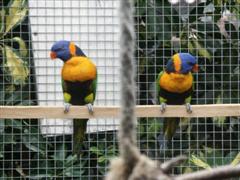Lorikeet - Red Collared
Scientific Name: Trichoglossus haematodus
Sun, 15th June, 2025 - 5:50 pm GMT
Sponsor Ads:

Alternative Name
Scientific Name: Trichoglossus haematodusBasic Info
By maturity, Red-collared Lorikeets grow to about 11 inches in length and have wing lengths of five and a half to six inches. It is, in fact, the largest of the Lorikeets and is easily confused with the Rainbow Lorikeet. In coloration, Red-collared Lorikeets have varying shades of medium to deep blue over their heads. Their napes are splashed with red, giving these lovely birds their name! The abdomen of males is a blackish-blue color, while on females it is a light color, usually yellowish-green. The throats of both sexes are yellow-green and the breasts brighten to a yellow or orange color! The undercarriage of the Red-collared Lorikeet is yellowish green.
Health
For the best nutrition, Red-collared Lorikeet owners may make up their own Lorikeet feed mixes. The first contains one part wheat germ cereal, two parts plain biscuit crumbs, and two parts high protein baby cereal moistened in a blender with a canned vegetable mix, water. Some suggest adding a tiny amount of honey, though it has been reported that honey may cause kidney and liver problems in wild individuals, and if it is fed in large amounts to captive individuals it can also cause illness. A calcium supplement may be added. The other mix contains a teaspoon of vitamin and mineral powder, one part glucose powder, two parts rice cereal, two parts canary-formulated egg and biscuit food, and two parts rice flour. As a treat, sponge cake softened with sugar water may be offered. Breeding To court a female, male Red-collared Lorikeets shriek at the top of their lungs, with much physical commotion as well. Red-collared Lorikeets are quite easy to breed in captivity; simply isolate the breeding pair and provide them with a nest box. Fill the nest box with sawdust and wood shavings to absorb droppings; this may be changed, as you feel necessary. They can be quite aggressive, defending their territory fiercely, during the breeding season. Generally, the breeding season varies by location. Clutches consist of an average of two eggs, which will incubate for a period of 24 days. Sometimes, Red-collared Lorikeets are prone to breaking or eating their eggs. The young will fledge in 10 weeks, and are fully mature by 11 months of age. Some pairs will breed three times in a year! They should remain with their parents for about two weeks before they are separated and hand reared.Habitat
Found throughout northern and eastern Australia including the Solomon Islands and New GuineaBehavior
Frequently taken for Rainbow Lorikeets, Red-collared Lorikeets are actually a distinct species who are incredibly brightly colored and lovely in their own right. Red-collared Lorikeets are a highly social species, living in large flocks in the wild. They are quite noisy and associate with other Lorikeet species. Red-collared Lorikeets are approachable by people when feeding. They eat insects, nectar, seeds, flowers, pollen, buds and fruits. Usually traced by noise, Red-collared Lorikeets are quite noisy even in aviculture. They do well kept in pairs or small groups but do not do well in small aviaries because they are territorial. Red-collared Lorikeets are very energetic and are curious about everything. Although they may be somewhat shy at first, they are very confiding once they trust you. Generally quite hardy, Red-collared Lorikeets are sensitive to temperature and need to be kept above 72 degrees Fahrenheit while they are being acclimatized. They do very well when kept in a nine by three by six foot aviary with an adjoining indoor shelter, and will need nesting boxes of about 12 by nine by ten inches in dimension. Red-collared Lorikeets are very playful and need lots of branches to chew in addition to fresh water at all times. Red-collared Lorikeets are highly intelligent. They can be taught a number of tricks and can also be toilet-trained!Origin
AustraliaHistory
Red-collared Lorikeets are found throughout northern and eastern Australia including the Solomon Islands and New Guinea. Although they are commonly kept in captivity in their native areas, Red-collared Lorikeets may be a bit more difficult to find outside of the Australian region. Some people feed these beautiful birds in the wild, but it should be noted that in some areas of Australia, such as Victoria it is illegal to feed honey as it may cause kidney and liver problems.Common Foods
They eat grain, fresh fruit, greenfood and sprouted seeds in captivity. Lorikeet feed made from honey, pollen and Brewer's Yeast is also important. Biscuit or rusk softened with milk should be offered, and mineral and vitamin supplements need to be givenSponsor Ads:
Whatever is not nailed down is the government's. Whatever the government can pry loose is not nailed down. -- Unknown
Lorikeet - Red Collared
Coded by: BGID® | ALL RIGHTS RESERVED Copyright © 2000-2025
Disclaimer | Privacy | Report Errors / Contact | Credits

 Preparing For China. China is growing their military. China Military Technology - can it keep up with the US?
Preparing For China. China is growing their military. China Military Technology - can it keep up with the US?  versus
versus 

 versus
versus 
 This Thread is about the North Korean Military itself - the kind of army, navy, and air force they have.
This Thread is about the North Korean Military itself - the kind of army, navy, and air force they have. 
 versus
versus 
 versus
versus  versus
versus